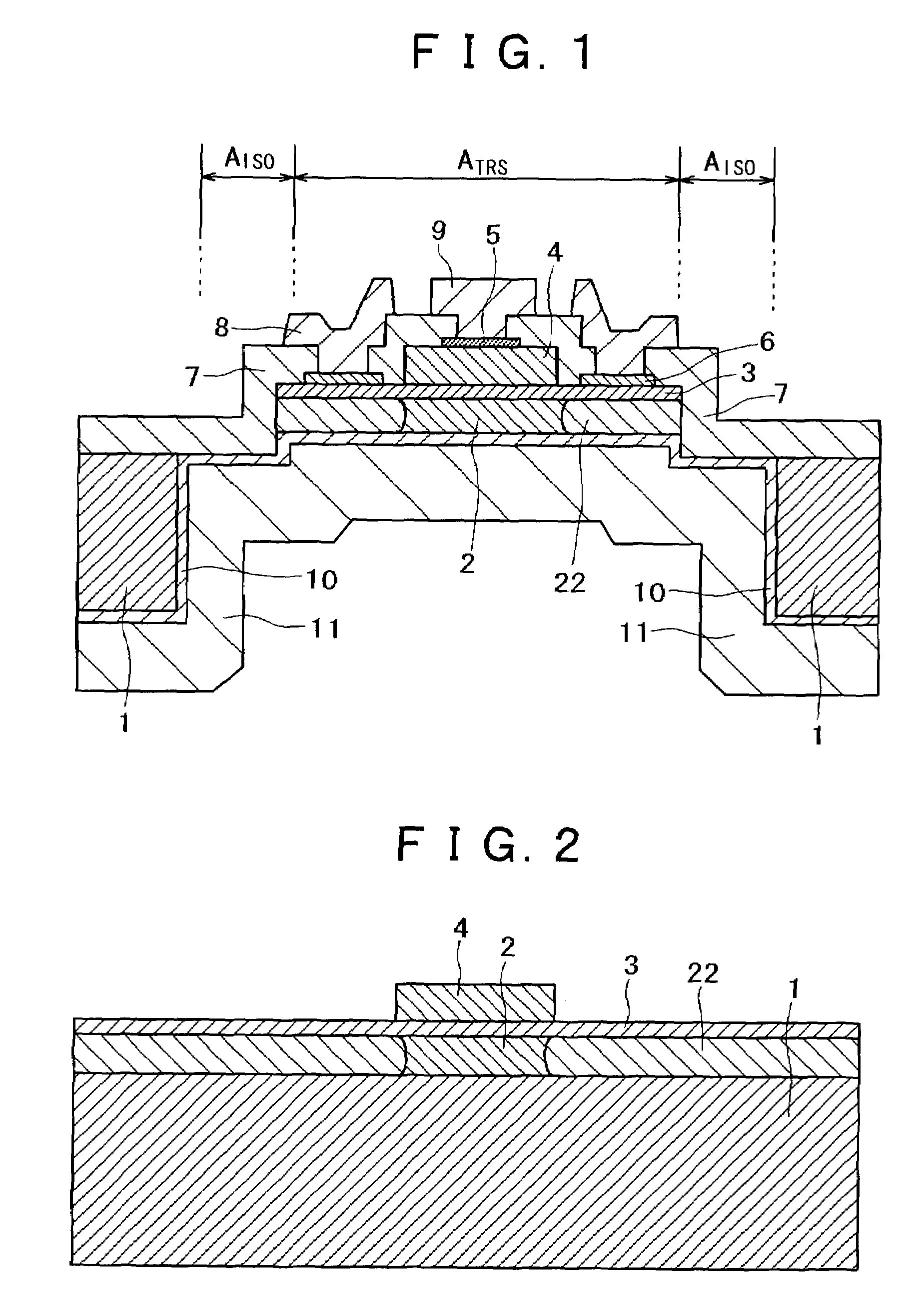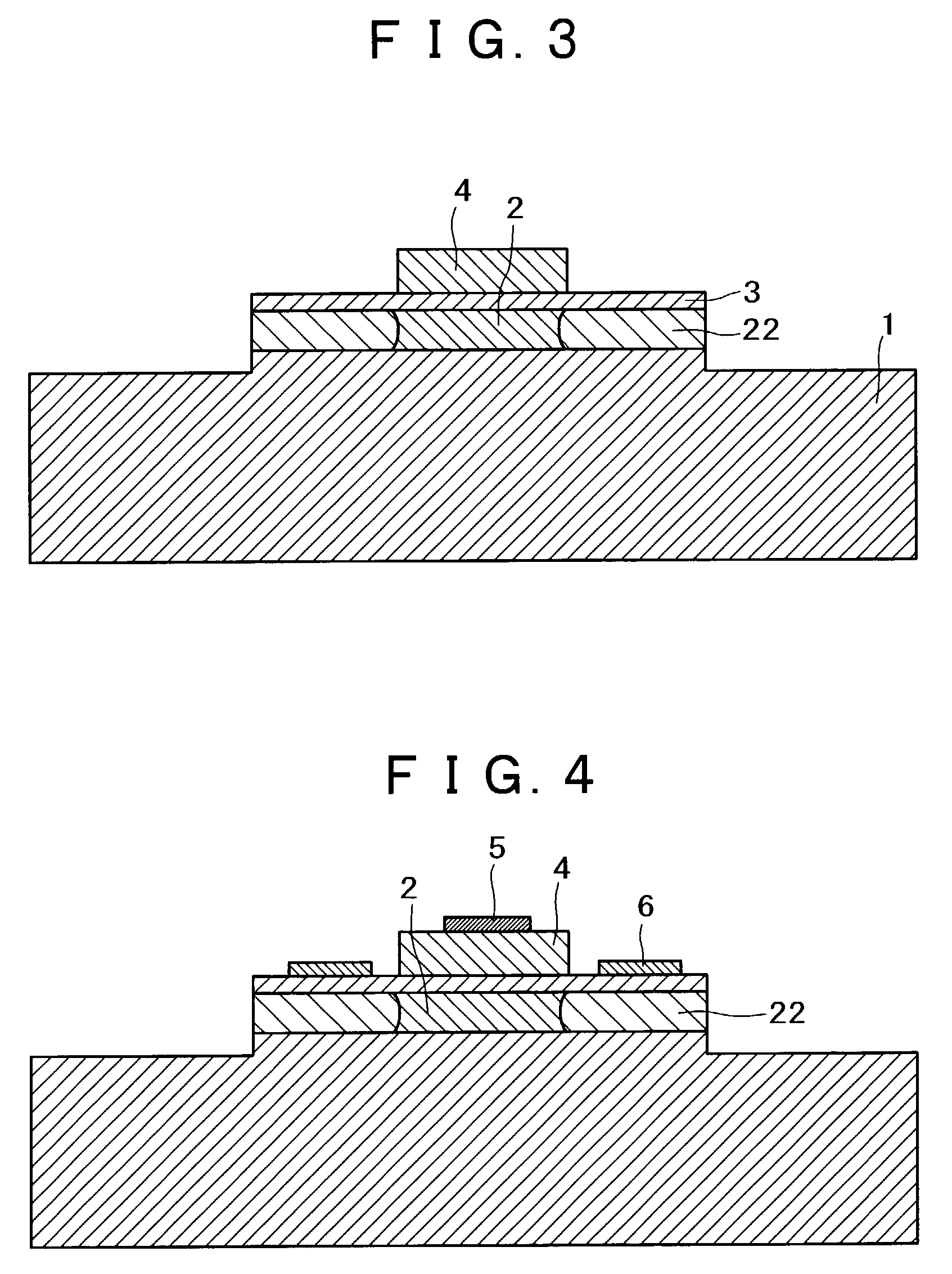Semiconductor device with high structural reliability and low parasitic capacitance
a technology of low parasitic capacitance and high structural reliability, applied in the direction of semiconductor devices, electrical devices, transistors, etc., can solve the problems of increasing chip cost, lowering production yield, increasing chip area, etc., and achieving high performance, preventing damage upon bonding, and moderating the accuracy of aligning margins
- Summary
- Abstract
- Description
- Claims
- Application Information
AI Technical Summary
Benefits of technology
Problems solved by technology
Method used
Image
Examples
first embodiment
[0039]FIG. 1 shows an example of the semiconductor device, in accordance with the present invention. In FIG. 1, are shown, by reference numerals, a semi-insulating GaAs substrate 1, an emitter layer 2, a base layer 3, a collector layer 4, a collector electrode 5, a base electrode 6, a surface protection insulating film 7 made of SiO2, a base wiring metal 8, a collector wiring metal 9, an emitter electrode 10, an emitter wiring metal 11 formed over the entire back side, and an emitter damaged region 22, respectively. In FIG. 1, ATRS is a transistor region which is occupied by the emitter layer 2. The transistor region ATRS also includes a damaged region 22.
[0040]In this embodiment, the opening of a via hole opened to the substrate 1 from the back side is wider than the transistor region ATRS, the emitter region 2 and the substrate 1 are isolated and connected by the surface protection insulating film 7, the emitter electrode 10 and the emitter wiring metal 11.
[0041]Then, a method of ...
embodiment 1
[0073]FIG. 12 shows a schematic cross sectional structural view of a semiconductor device of the invention. This is different described above in that the GaAs substrate 1 is removed over the entire back side.
[0074]The structure can be obtained by forming the insulating film of the surface protection film 7 formed in the step (5) of Embodiment 1 with a polyimide layer 70 (coated to 1 μm thickness and cured at 300° C. in a nitrogen ambient), and removing the GaAs substrate 1 over the entire back side without patterning by photolithography upon etching from the back side in the step (8).
[0075]The feature of the structure resides in that since the GaAs substrate is removed completely and the transistor region is left in an island shape in an extremely thin structure of about 10 μm thickness comprising a polyimide film 70 and an emitter electrode 10 and emitter wirings 11 of the metal layer, the structure has flexibility. Therefore, the transistor of this embodiment can be bonded directl...
embodiment 5
[0077]FIG. 13 shows a schematic cross sectional structural view and FIG. 14 shows a schematic planar structural view of The manufacturing steps of this embodiment are as described below.
[0078]In Embodiment 1 described above, a step of fabricating a surface protection insulating film 7 is conducted between the step (7) and the step (8) and, finally, the semiconductor substrate is removed and openings 40 are formed as shown in FIG. 13 in a region where the transistor region and the substrate region are connected by the surface protection layer. FIG. 14 is a schematic structural plan view showing the same on the side of the surface. FIG. 13 is a cross sectional view for a portion taken along line A–A′ in FIG. 14. In the plan view of FIG. 14, the collector wirings 9 and the base wirings 8 are not illustrated for making the structure clearer.
[0079]In the succeeding step (9), a step of covering the openings 40 with a photoresist upon depositing an emitter electrode is added. Au is no mor...
PUM
 Login to View More
Login to View More Abstract
Description
Claims
Application Information
 Login to View More
Login to View More - R&D
- Intellectual Property
- Life Sciences
- Materials
- Tech Scout
- Unparalleled Data Quality
- Higher Quality Content
- 60% Fewer Hallucinations
Browse by: Latest US Patents, China's latest patents, Technical Efficacy Thesaurus, Application Domain, Technology Topic, Popular Technical Reports.
© 2025 PatSnap. All rights reserved.Legal|Privacy policy|Modern Slavery Act Transparency Statement|Sitemap|About US| Contact US: help@patsnap.com



